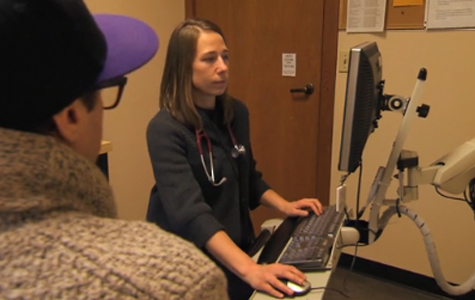
Angel Mathis, ARNP was the primary care provider (PCP) featured in Daniel’s Story, a video chronicling a young man named Daniel and his journey with depression. Angel worked with a Collaborative Care team to deliver Daniel’s depression care at County Doctor, a community health center in the Mental Health Integration Program. Angel joined Country Doctor in 2008 as a registered nurse practitioner with a Master of Nursing and a Master of Public Health from the University of Washington. Angel’s background drives her to focus on disease prevention in her clinical practice, working with individuals, families, and communities to encourage the development and maintenance of healthy environments. Angel interviewed with the AIMS Center in 2014 to shed light on the PCP’s role in Collaborative Care.
Q: How did Collaborative Care change the way you provide treatment?
When I see a patient in primary care, I have 15 minutes with them. It’s very difficult to make a mental health diagnosis in that time period. You can imagine how alarming it is to be labeled with a mental health diagnosis during the first 15 minutes of your interaction with someone.
Rather than jumping straight to a diagnosis, I am able to refer the patient to our Collaborative Care team. They get an hour-long initial evaluation with our care manager. Sometimes it can take two sessions to clarify the diagnosis, but in Collaborative Care there is someone who has the time to do those extensive evaluations to fully assess symptoms and get the correct diagnosis.
Once a diagnosis is made, the psychiatric consultant and care manager help me develop a treatment plan. I am more confident in the treatment we provide and that the treatment will work. If it doesn’t, I have the support I need to figure out the next steps.
Q: Does Collaborative Care add to your workload?
Collaborative Care is not more work for me in the overall sense, it just shifts the way we approach treatment. As a primary care provider, it requires more coordination between providers, more reading, more notes, and less in-person time with the patient. The care manager, in turn, has more face-time with the patient and is able to direct that time in a useful way. Collaborative Care improves the quality of care we provide. It is a very patient-centered approach.
Q: What has surprised you about practicing Collaborative Care?
I have been surprised by how available our psychiatric consultant has been, with returning e-mails, phone calls, pages, after hours. It has been very pleasant to feel supported in that way.
Q: Did you have any challenges implementing Collaborative Care in your practice?
It has been a bit of a change from the traditional treatment plan, but I can’t think of any challenges when implementing the program specifically. Before, if psychiatric services were available, they would be provided by an outside clinic and I would not have any interaction with the psychiatrist or the therapist. I notice when depressed patients are referred outside of our clinic, care can become fragmented. My preference now is to have everyone receive treatment right here, in our clinic.
Q: Why do you think care gets fragmented when the providers are outside of your clinic?
The problem with fragmented care comes from not knowing the psychiatrist or the therapist, and not having freely accessible records to review. Here in our clinic, we are able to look at each other’s notes within the patient registry and know what has been discussed. The care manager knows what the medical treatment plan is and is able to follow up with our patients to make sure they are following the plan. I also know the mental health plan, which allows me to check in with patients to make sure they are adhering to it.
Q: Do you think treating mental health conditions in primary care makes sense?
It makes a great deal of sense. Most people have some sort of mental health condition, diagnosis or not. The most likely place for those people to access care is their primary care provider’s office. It’s very satisfying to provide care when you have support, and when a patient is engaged in their treatment plan, the outcomes are usually positive.